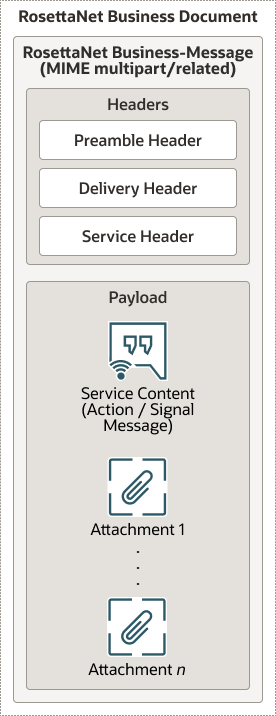About RosettaNet
B2B for Oracle Integration supports the nonproprietary, XML-based RosettaNet standard to exchange documents over the internet. RosettaNet standards prescribe when to exchange, acknowledge, or confirm information, and how to package and physically exchange messages between trading partners.
RosettaNet Concepts
RosettaNet is a global standard for electronic B2B communication and collaboration in the supply chain management industry. RosettaNet includes a set of standardized message formats, business processes, and implementation frameworks to facilitate electronic data exchange and collaboration between trading partners.
- RosettaNet Implementation Framework (RNIF)
RNIF is a collection of specifications used to implement message exchange between trading partners over the internet. RNIF provides the following guidelines for RosettaNet partner interface processes (PIPs) messages and business signals:
- Transport
- Packaging
- Authorization
- Authentication
- Encryption
- Compression
- Digital signature
- Message digest
- Nonrepudiation (so trading partners cannot dispute receiving a message)
A RosettaNet business document is structured as follows:

- Partner Interface Processes (PIPs)
RosettaNet PIPs define the sequence of steps required to execute a business process between two trading partners. B2B for Oracle Integration supports all PIPs. For example, the message exchange sequence for PIP 3A4 (Request Purchase Order) is as follows. This is a double-action PIP. For a double-action PIP, the initiator receives a response message and replies with an acknowledgment.

A functional view of PIP 3A4 in action is as follows.

For a single-action PIP, the only response is an acknowledgment signal message.
See PIP Directory.
- Business and technical dictionaries
B2B for Oracle Integration Rosetta support doesn’t interpret the RosettaNet dictionaries. The dictionaries are left to interpretation by the backend applications.
How B2B for Oracle Integration Supports RosettaNet
You follow this workflow to use RosettaNet in B2B for Oracle Integration:
- You configure the RosettaNet Adapter connection in the trigger direction and invoke direction. See RosettaNet Adapter Capabilities in Using the RosettaNet Adapter with Oracle Integration 3. This configuration is similar to the AS2 Adapter.
- You create a RosettaNet schema (by uploading the required PIP) and document. See B2B Schemas and B2B Documents.
- You correlate the message sequence by creating an XPath expression in the document. This ensures that the business document messages and wire messages are in the proper order at runtime on the Track B2B messages page.
- You assign a RosettaNet-required DUNS business identifier with a nine digit, alphanumeric character value when defining the trading partners and select RosettaNet as the transport type. See Manage B2B Trading Partners.
- You track the business document and wire messages for the B2B
integration during runtime. See B2B Message Tracking.
A Collaboration tab is provided for viewing. This tab enables you to ensure that the sequence of messages is correct at runtime. See Work with Business Messages.
Watch a video to learn more: